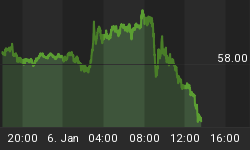Gold really starts to glitter when you can't get an "honest" return on your money market investments in any major currency. That is, when the inflation rate is above money market rates in all major currencies, investors turn to gold as a store of value. Looking at the dollar and the euro, currently, you can get an honest return on your money. In May, the year-over-year percent change in the all-items U.S. CPI was 2.8%. The fed funds rate target was 3.00%. Thus, the inflation-adjusted fed funds rate was positive by 20 basis points - the first positive "real" fed funds rate since September 2002. With May year-over-year eurozone CPI inflation at 1.9% and European Central Bank's (ECB) minimum-bid repo rate (the equivalent of the fed funds rate) at 2.00%, the "real" ECB rate was positive by 10 basis points. Although both the Fed's and the ECB's policy rates were in positive territory in May vs. their respective inflation rates and only 10 basis points apart from each other, their paths toward near parity have been different, as can be seen in Chart 1. The real fed funds rate has spent more time in recent years below zero than has the real ECB rate. With the ECB having held its policy rate steady at 2.00% since March 2003, there has been a slow descent in the real ECB rate as eurozone inflation has picked up. After reaching a recent low in May 2004, the real fed funds rate has been battling its way back into positive territory through a combination of moderating inflation and a rising nominal fed funds rate target.
Chart 1
"Real" Central Bank Policy Rates*: Fed Funds and ECB(percent)
* Policy interest rate minus year-over-year percent change in respective CPI.
With eurozone economic growth faltering, the ECB is under increasing pressure to cut its policy rate. It is doubtful that eurozone consumer inflation would decline by as many basis points as the interest rate cut. Thus, if the ECB were to lower rates in the near term, it is likely that the real ECB rate could turn negative again. It would be a hyperbole to say that the Fed is under increasing pressure to pause in its interest rate increases. But leading indicators, especially the flatter yield curve and the slowdown in real money supply growth are sending a strong signal that a soft landing is at hand for the U.S. economy. And if the Fed continues much longer on it course of interest rate hikes, it runs the risk of bursting the housing bubble and plunging the U.S. economy into a recession. So, although there is not overt pressure on the Fed to call a cease fire in its rate hikes, there is a growing expectation that it might be near the end of Phase 1, at least, of this tightening cycle. At the same time, with energy prices flaring up again, all-items CPI inflation might start to climb again.
I wonder if the gold market is beginning to reflect the expectation that an honest return on one's money may be hard to come by in the not-too-distant future. Let's take a look at the behavior of gold prices in U.S. dollar terms and euro terms in recent years and weeks. Chart 2 shows these gold prices on a monthly basis from January 2001 through May 2005. During that period, the dollar price of gold rose by a net 51.1%. In contrast, the euro price of gold rose by only a net 13.6%. You will recall that from 2002 through 2004, the dollar was depreciating against the euro. That would put bias upward the dollar price of gold.
Chart 2
Chart 3 shows the dollar and euro prices of gold on a daily basis. These prices are moving in closer tandem than they have in recent years. So far in June of this year, both the dollar and euro prices of gold have been rising. From May 31 through today, June 23 (Chart 3 goes up only through June 22), the dollar price of gold has risen by 6.5% while the euro price has risen by 9.3%. The larger percentage increase in the euro price of gold is related to the depreciation of the euro vs. the dollar. But the important take away is that the price of gold is rising significantly in both dollar and euro terms. As I said at the outset, gold really begins to glitter when investors cannot get an honest return on their money. I think those investor suspicions are beginning to set in.
Chart 3
















